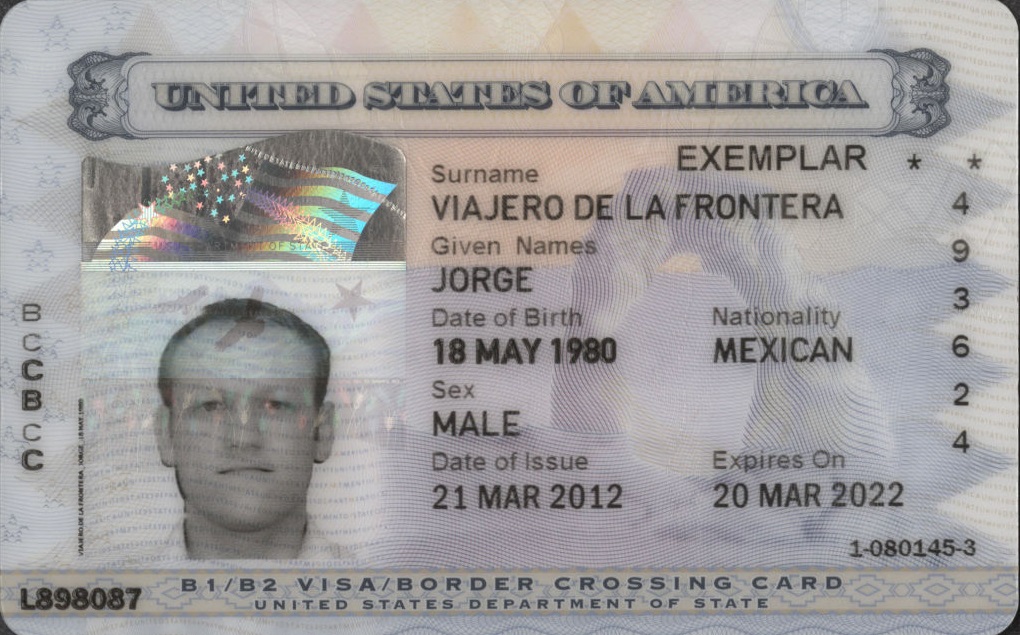Border Crossing Card on:
[Wikipedia]
[Google]
[Amazon]
 A Border Crossing Card (BCC) is an identity document used by nationals of Mexico to enter the United States. As a standalone document, the BCC allows its holder to visit the border areas of the United States when entering by land or sea directly from Mexico for up to 30 days.Extension of Border Zone in the State of New Mexico
A Border Crossing Card (BCC) is an identity document used by nationals of Mexico to enter the United States. As a standalone document, the BCC allows its holder to visit the border areas of the United States when entering by land or sea directly from Mexico for up to 30 days.Extension of Border Zone in the State of New Mexico
Federal Register, 12 June 2013.8 CFR §235.1, Scope of examination
Electronic Code of Federal Regulations. The document also functions as a B visa, B1/B2 visa when presented with a valid Mexican passport, for entry to any part of the United States by any means of transportation.8 CFR §212.1, Documentary requirements for nonimmigrants
Electronic Code of Federal Regulations.
Border Crossing Card
International travel documents
 A Border Crossing Card (BCC) is an identity document used by nationals of Mexico to enter the United States. As a standalone document, the BCC allows its holder to visit the border areas of the United States when entering by land or sea directly from Mexico for up to 30 days.Extension of Border Zone in the State of New Mexico
A Border Crossing Card (BCC) is an identity document used by nationals of Mexico to enter the United States. As a standalone document, the BCC allows its holder to visit the border areas of the United States when entering by land or sea directly from Mexico for up to 30 days.Extension of Border Zone in the State of New MexicoFederal Register, 12 June 2013.8 CFR §235.1, Scope of examination
Electronic Code of Federal Regulations. The document also functions as a B visa, B1/B2 visa when presented with a valid Mexican passport, for entry to any part of the United States by any means of transportation.8 CFR §212.1, Documentary requirements for nonimmigrants
Electronic Code of Federal Regulations.
History
Since 1953, Mexico and the United States have agreed to make special accommodations for Mexican nationals who cross the Mexico–United States border into the immediate area to promote the economic stability of the region. On November 12, 1953, the two countries entered into an agreement concerning the border area, which included a provision allowing Mexican nationals who resided near the border to be issued border-crossing identification cards. These cards could be used for multiple applications for admission during the validity of the card. In 1982, the border zone that may be visited with a BCC was defined as the area within from the border. In 1999, the portion of the zone in Arizona was expanded to from the border. In 2004, the allowed period of stay in the border zone with a BCC was expanded from 72 hours to 30 days. In 2013, the portion of the zone in New Mexico was expanded to from the border or up to Interstate 10.Eligibility
The BCC is issued only to Mexican nationals residing in Mexico and by the U.S. diplomatic missions in Mexico. Applicants must satisfy the same requirements as for a B visa, including demonstrating their ties to Mexico that would compel them to return after a temporary stay in the United States.Description
The first generation of Machine-readable medium, machine-readable BCCs, known as "laser visas", was produced from April 1, 1998, until September 30, 2008. The laminated, credit card-size document is both a BCC and a B1/B2 visitor visa. The cards are valid for travel until the expiration date on the front of the card, usually ten years after issuance. They are nearly identical to the previous generation Green card, U.S. permanent resident card. October 1, 2008, marked the beginning of production of a second generation B-1 visa, B1/B-2 visa, B2 visa/BCC. The new card is similar in size to the old BCC, but contains enhanced graphics and technology. The original BCC was produced by the now defunct Immigration and Naturalization Service but the current card is produced by the United States Department of State, Department of State. It is virtually identical to the United States Passport Card, U.S. passport card, which is issued to nationals of the United States for the purposes of land and sea border crossings, in its general design layout. The card includes an RFID chip and integrated contactless circuit and is part of the same PASS system as the passport card.Use
As a standalone document, the BCC allows its holder to visit the following border areas of the United States when entering by land or sea, for up to 30 days: *California within of the border *Arizona within of the border *New Mexico within of the border or up to Interstate 10, whichever is further north *Texas within of the border When presented with a Mexican passport, the BCC functions as a B visa, accepted for entry to any part of the United States by any means of transportation.See also
* B visa * Enhanced driver's license * NEXUS card * United States Passport CardReferences
{{reflistExternal links
Border Crossing Card
International travel documents